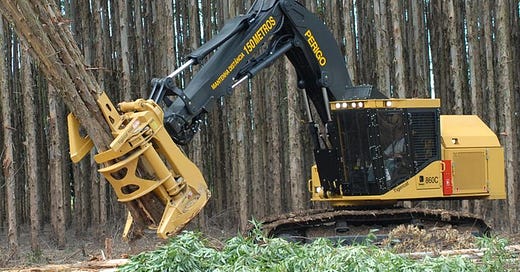Post-wildfire timber being salvaged in northeastern BC
For months, Peace River North MLA Dan Davies and Peace River South MLA Mike Bernier have been asking the provincial government to make burnt timber available to companies throughout northeastern British Columbia, which would aid in the clean-up of the forest floor and provide access for reforestation efforts. This clean-up and reforestation would create employment opportunities for people in the Peace region.
In a letter he wrote to the Minister of Forests Bruce Ralston in July, Davies urged the government to develop a program to make use of the charred and damaged black spruce, aspen, pine, and tamarack trees in the region that are still valuable sources of fibre, even after a wildfire. Various sources say that this timber is viable for 12 to 24 months following a wildfire.
“[This window] has already started, and it is vital that decisions are made in a quick, timely manner in order to take advantage of this opportunity,” Davies wrote.
Bernier, who serves as Shadow Minister of Forests, has suggested that the Ministry come up with a policy program – separate from the usual cutting permits – to salvage the wood after a fire has gone through before the fibre starts to deteriorate.
“Instead of letting it just rot or sit there and fall to the ground and continue being a hazard for future years for forest fires, why don’t you just have a policy that says well that wood’s no good now anyway, put it up for tender and let companies bid on it, harvest that wood and at least get some value out of it,” Bernier said on Tuesday.
Now, nine months after the wildfires in northeastern BC began, there is movement from the Ministry of Forests.
The Province says it has started to receive applications to salvage timber from forests burned in 2023, with 22 cutting permits received so far province wide. Seven of these cutting permits have been issued in the Peace region, the Ministry said, with additional permits under review. In addition, BC Timber Sales developed 30 new timber sales licences which are scheduled for sale in the near future, with four of these located in the Peace and total 140,000 cubic metres of salvage timber.
To help facilitate speedier access to wildfire damaged trees, the government has also developed new Wildfire Salvage Opportunity Agreements, which are aimed at increasing First Nation participation, the Ministry said.
“We know access to timber is critical for the people, communities and businesses that rely on BC forest for their livelihoods,” a statement from the Ministry read. “Expediting wildfire salvage is a priority to ensure we do everything we can to minimize economic impacts and accelerate recovery of the land.”
To date, seven major tenure holders and five First Nations have received permits for salvage logging for areas damaged by the 2023 wildfires. However, in the Ministry’s statement to The Broken Typewriter, it made no mention of reforestation efforts.
When a company harvests trees in the normal fashion, replanting is part of the permitting package, Bernier explained. “After an area’s been harvested, it has to be replanted.”
So, instead of letting Mother Nature take its course and leave the trees to rot for 25 years, “why not get some economic value out of that burnt wood and then have companies go in and reforest. You’re basically 25 years ahead of Mother Nature, regrowing and reestablishing the ecosystem,” he said.
One local company that is making good use of the salvaged timber and fibre is Louisiana Pacific’s Peace Valley OSB plant in Fort St. John.
“Our Fort St. John mill is currently utilizing salvaged timber from the wildfires that occurred last year. We use deciduous trees, which remain viable for our products for two to three seasons following wildfire impact,” said Breeanna Straessle, Senior Director of Corporate Communications.
However, the salvaged timber LP is using was acquired through a partnership with local conifer mills and is considered part of the company’s annual allowable cut, not one of the salvaged timber cutting permits.



